猪性腺原始生殖细胞的多能和生殖标记基因表达及X染色体再激活状态分析
IF 2.4
2区 农林科学
Q3 REPRODUCTIVE BIOLOGY
引用次数: 0
摘要
性腺原始生殖细胞(PGC)具有独特的多能性和 X 染色体活性。然而,大量证据表明,PGCs 在不同物种间存在发育变异。本研究旨在评估猪性腺PGCs的多能状态、特定基因表达模式和X染色体再激活(XCR)。单细胞RNA-seq发现性腺PGCs群体内部存在显著的异质性。值得注意的是,这些 PGCs 表达了高水平的多能性标记 OCT4、PRDM14 和 NANOG,但缺乏 SOX2 表达。通过筛选标记基因和随后的蛋白表达验证,我们发现生长分化因子3(GDF3)是猪性腺PGCs的特异性表面标记物,这有助于高效纯化这些PGCs以进行进一步研究。此外,对性腺 PGCs 的分析表明它们具有完整的 XCR。这表现在缺乏抑制性组蛋白修饰(H3K27me3、H3K9me3和H2AK119ub)、缺乏X非活性特异性转录本(XIST)RNA FISH信号以及X连锁基因的加倍表达。此外,这些 PGCs 表达了大量与表观遗传修饰、染色质重塑和 XIST 相关 RNA 结合有关的基因。这些因子可能在调控多能性和X染色体活性方面起着至关重要的作用。总之,这项研究揭示了猪性腺 PGCs 的异质性,并确定 GDF3 为特异性表面标记物。它还阐明了多能性转录因子的表达模式以及 XCR 所涉及的事件。本文章由计算机程序翻译,如有差异,请以英文原文为准。
Analysis of the pluripotent and germline marker gene expression, and the state of X chromosome reactivation of primordial germ cells in pig gonads
The gonadal primordial germ cells (PGCs) possess a unique state of pluripotency and X chromosome activity. However, extensive evidence indicates developmental variability in PGCs across different species. This study aims to evaluate the pluripotency status, specific gene expression patterns, and X chromosome reactivation (XCR) of pig gonadal PGCs. Single-cell RNA-seq revealed significant heterogeneity within the population of gonadal PGCs. Notably, these PGCs expressed high levels of pluripotency markers OCT4, PRDM14, and NANOG, while lacking SOX2 expression. Through the screening of marker genes and subsequent protein expression validation, we identified growth differentiation factor 3 (GDF3) as a specific surface marker for pig gonadal PGCs, facilitating their efficient purification for further study. Furthermore, analysis of gonadal PGCs demonstrated complete XCR. This was evidenced by the absence of repressive histone modifications (H3K27me3, H3K9me3, and H2AK119ub), the lack of X inactive specific transcript (XIST) RNA FISH signal, and the doubled expression of X-linked genes. Additionally, these PGCs expressed high levels of genes associated with epigenetic modification, chromatin remodeling, and XIST-associated RNA-binding. These factors likely play a crucial role in regulating pluripotency and X chromosome activity. In summary, this study reveals the heterogeneity in pig gonadal PGCs and identifies GDF3 as a specific surface marker. It also elucidates the expression patterns of pluripotency transcription factors and the events involved in XCR.
求助全文
通过发布文献求助,成功后即可免费获取论文全文。
去求助
来源期刊

Theriogenology
农林科学-生殖生物学
CiteScore
5.50
自引率
14.30%
发文量
387
审稿时长
72 days
期刊介绍:
Theriogenology provides an international forum for researchers, clinicians, and industry professionals in animal reproductive biology. This acclaimed journal publishes articles on a wide range of topics in reproductive and developmental biology, of domestic mammal, avian, and aquatic species as well as wild species which are the object of veterinary care in research or conservation programs.
 求助内容:
求助内容: 应助结果提醒方式:
应助结果提醒方式:


